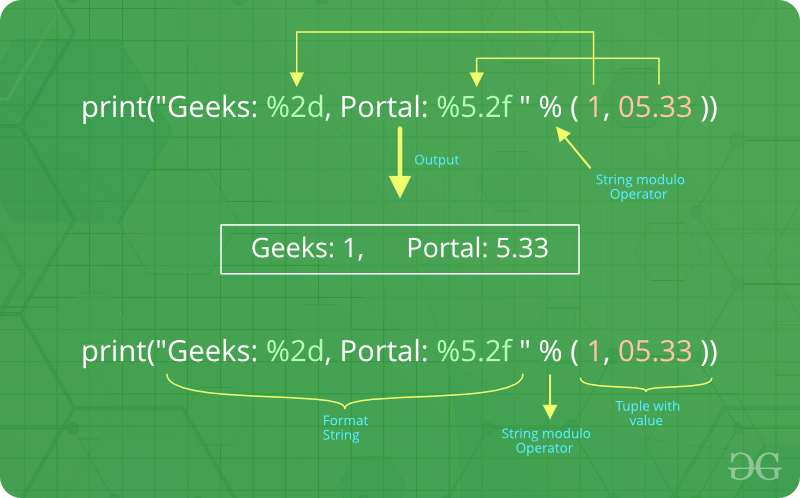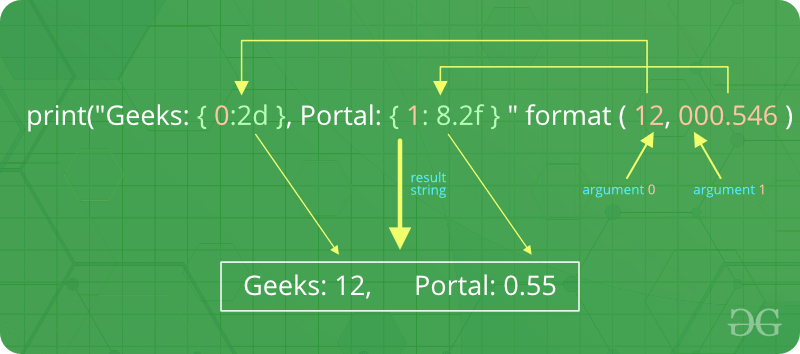本文概述
有几种方式可以显示程序的输出, 可以以人类可读的形式打印数据, 也可以将数据写入文件以备将来使用。有时, 用户通常希望更多地控制输出的格式, 而不是简单地打印以空格分隔的值。有几种格式化输出的方法。
- 使用格式化的字符串文字, 请在开头的引号或三引号之前使用f或F开头的字符串。
- 的str.format()字符串方法可帮助用户获得更出色的输出
- 用户可以使用字符串切片和连接操作来创建用户所需的任何布局, 从而完成所有字符串处理。字符串类型有一些方法可以执行有用的操作, 以将字符串填充到给定的列宽。
使用String模运算符(%)格式化输出:
%运算符还可以用于字符串格式化。它解释左参数很像要应用于右参数的printf()样式格式字符串。在Python中, 没有printf()函数, 但旧的printf的功能包含在Python中。为此, 字符串类将模运算符%重载以执行字符串格式化。因此, 它通常被称为字符串模(或有时甚至称为模数)运算符。
字符串模运算符(%)在Python(3.x)中仍然可用, 并且用户正在广泛使用它。但是如今, 格式化的旧样式已从该语言中删除。
Python3
# Python program showing how to use
# string modulo operator(%) to print
# fancier output
# print integer and float value
print ( "Geeks : % 2d, Portal : % 5.2f" % ( 1 , 05.333 ))
# print integer value
print ( "Total students : % 3d, Boys : % 2d" % ( 240 , 120 ))
# print octal value
print ( "% 7.3o" % ( 25 ))
# print exponential value
print ( "% 10.3E" % ( 356.08977 ))输出:
Geeks : 1, Portal : 5.33
Total students : 240, Boys : 120
031
3.561E+02
在我们的示例中有两个:"%2d"和"%5.2f"。格式占位符的常规语法为:
%[flags][width][.precision]type让我们看一下示例中的占位符。
- 第一个占位符"%2d"用于元组的第一个组成部分, 即整数1。该数字将打印2个字符。由于1仅包含一位数字, 因此输出将填充1个前导空格。
- 第二个"%5.2f"是浮点数的格式描述。与其他占位符一样, 它以%字符引入。其次是字符串应包含的总位数。该数字包括小数点和所有数字, 即小数点之前和之后的数字。
- 我们的浮点数05.333必须使用5个字符格式化。数字或精度的小数部分设置为2, 即"。"后面的数字在我们的占位符中。最后, 占位符的最后一个字符" f"代表" float"。
使用format方法格式化输出:
在Python(2.6)中添加了format()方法。字符串的格式化方法需要更多的人工。用户使用{}标记变量将被替换的位置, 并可以提供详细的格式指令, 但是用户还需要提供要格式化的信息。通过此方法, 我们可以通过位置格式将输出中的元素连接起来。例如 -
代码1:
Python3
# Python program showing
# use of format() method
# using format() method
print ( 'I love {} for "{}!"' . format ( 'Geeks' , 'Geeks' ))
# using format() method and refering
# a position of the object
print ( '{0} and {1}' . format ( 'Geeks' , 'Portal' ))
print ( '{1} and {0}' . format ( 'Geeks' , 'Portal' ))输出:
I love Geeks for "Geeks!"
Geeks and Portal
Portal and Geeks其中的方括号和字符(称为
格式栏位
)替换为传递给format()方法的对象。括号中的数字可用于引用传递给format()方法的对象的位置。
代码2:
Python3
# Python program showing
# a use of format() method
# combining positional and keyword arguments
print ( 'Number one portal is {0}, {1}, and {other}.'
. format ( 'Geeks' , 'For' , other = 'Geeks' ))
# using format() method with number
print ( "Geeks :{0:2d}, Portal :{1:8.2f}" .
format ( 12 , 00.546 ))
# Changing positional argument
print ( "Second argument: {1:3d}, first one: {0:7.2f}" .
format ( 47.42 , 11 ))
print ( "Geeks: {a:5d}, Portal: {p:8.2f}" .
format (a = 453 , p = 59.058 ))输出如下:
Number one portal is Geeks, For, and Geeks.
Geeks :12, Portal : 0.55
Second argument: 11, first one: 47.42
Geeks: 453, Portal: 59.06下图和一个示例用法描述了format方法如何处理位置参数:

代码3:
Python3
# Python program to
# show format () is
# used in dictionary
tab = { 'geeks' : 4127 , 'for' : 4098 , 'geek' : 8637678 }
# using format() in dictionary
print ( 'Geeks: {0[geeks]:d}; For: {0[for]:d}; '
'Geeks: {0[geek]:d}' . format (tab))
data = dict (fun = "lsbin" , adj = "Portal" )
# using format() in dictionary
print ( "I love {fun} computer {adj}" . format ( * * data))输出如下:
Geeks: 4127; For: 4098; Geeks: 8637678
I love lsbin computer Portal使用String方法格式化输出:
通过使用字符串切片和串联操作来格式化此输出。字符串类型具有一些方法, 可以帮助以一种更奇妙的方式格式化输出。一些有助于格式化输出的方法是
str.ljust()
,
str.rjust()
,
str.centre()
Python3
# Python program to
# format a output using
# string() method
cstr = "I love lsbin"
# Printing the center aligned
# string with fillchr
print ( "Center aligned string with fillchr: " )
print (cstr.center( 40 , '#' ))
# Printing the left aligned
# string with "-" padding
print ( "The left aligned string is : " )
print (cstr.ljust( 40 , '-' ))
# Printing the right aligned string
# with "-" padding
print ( "The right aligned string is : " )
print (cstr.rjust( 40 , '-' ))输出如下:
Center aligned string with fillchr:
##########I love lsbin##########
The left aligned string is :
I love lsbin--------------------
The right aligned string is :
--------------------I love lsbin注意怪胎!巩固你的基础Python编程基础课程和学习基础知识。
首先, 你的面试准备可通过以下方式增强你的数据结构概念:Python DS课程。

